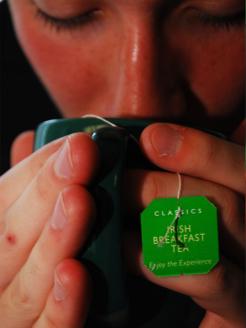
Riley Hagel--Drinking tea has been found to positively affect health.

Camellia Sinensis is well-known to people all around the world but maybe not by its botanical name. People enjoy the benefits of this plant every day, as the Camellia Sinensis dried leaves are commonly known and used as tea.
Whether it is iced, hot or bottled, tea is a major obsession for many people and, depending on which kind is consumed, there can be some health benefits.
“It is not the tea that is the problem, it is what we put into the tea,” Dean of the College of Allied Health Charles Sands said. “The main thing that most tea does is that it provides antioxidants which fight free radicals. Free radicals are the thing that will eventually cause inflammation which may end up with problems with respect to cancer or potentially heart disease.”
The teas with these antioxidants that come from the Camellia Sinensis plant are black, white, green and oolong.
However, there are a few types of teas that come from a different plant, such as Red Rooibos and herbal tea, according to Gloria Tsang, RD of HealthCastle.com, which do not have the particular health-promoting properties.
“There is not a lot of strong evidence that tea provides a great protective effect from a disease perspective,” Sands said. “The benefits that some studies and research say are that tea can help with cardiovascular health, liver function, maintain a well-balanced mental state, reduce risk of skin cancers, support the immune system, increase bone density, fight cavities, counteract diabetes and even reduce body fat.”
Unlike oatmeal or Cheerios, the relationship between tea and preventing particular diseases has not been clearly determined as to how much should be consumed for these protective measures.
“Clearly at the cellular level there are protective measures,” Sands said. “But tea has not been studied very well for us to be able to say for example that if you consume 8 ounces of brewed tea a day that you have an x, y, z percentage of either getting or not getting a particular disease.”
The differences between the types of teas are related to when the tea leaf is picked and the processing of this wonderful plant.
According to HealthCastle.com, the more processing tea leaves undergo, the darker they will turn. White tea is picked before spring when it is still young and does not have much chlorophyll, while black and oolong teas are partially dried, crushed and fermented.
The level of caffeine that is found in tea (40 mg) is less than a cup of coffee, which contains 85mg. Decaf tea has some of the same benefits if it is made with the Camellia Sinensis plant.
In terms of antioxidants, the process of Green Tea is done quickly, therefore it does not have the same treatment as other teas. As a result, it maintains its green leaves and retains the highest level of antioxidants.
“Tea probably is not quite the great thing people promote it to be but it certainly is not a bad thing,” Sands said. “It is a good thing to encourage tea consumption because it typically replaces other drinks that would not be as good for you. Tea can save you from soda that rots teeth, coffee that is acid on the stomach and water that is sometimes too bland. Try it, you will like it.”


